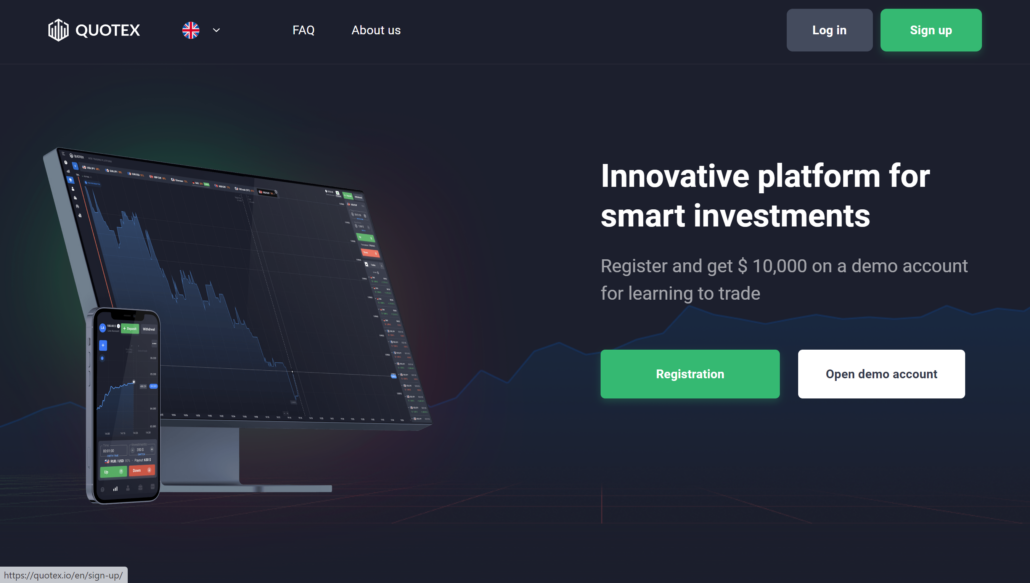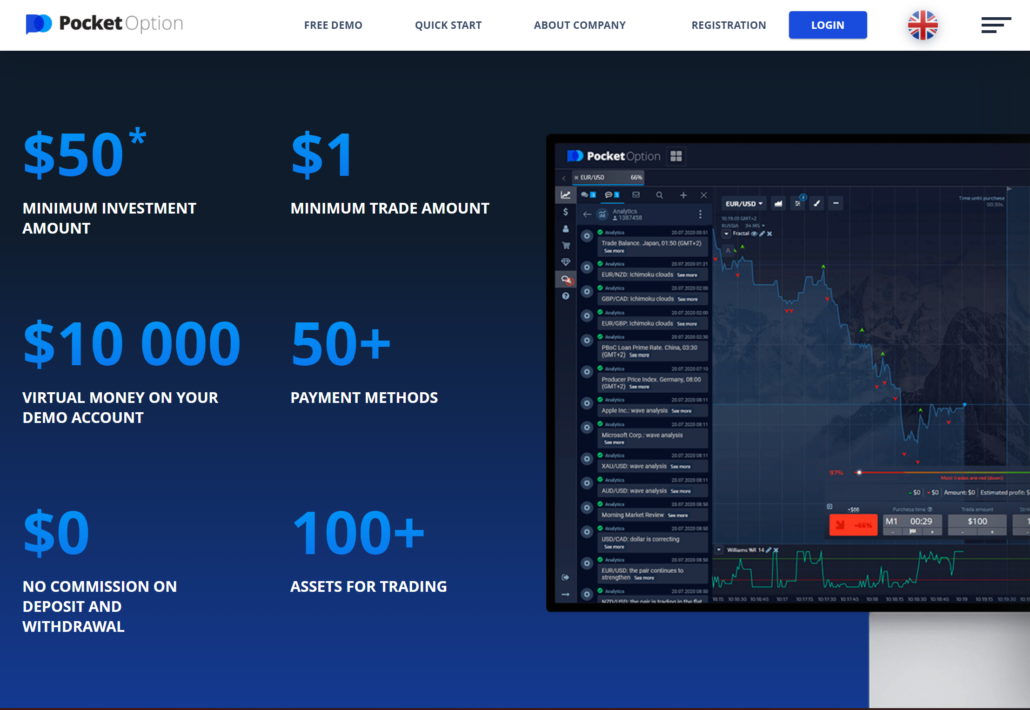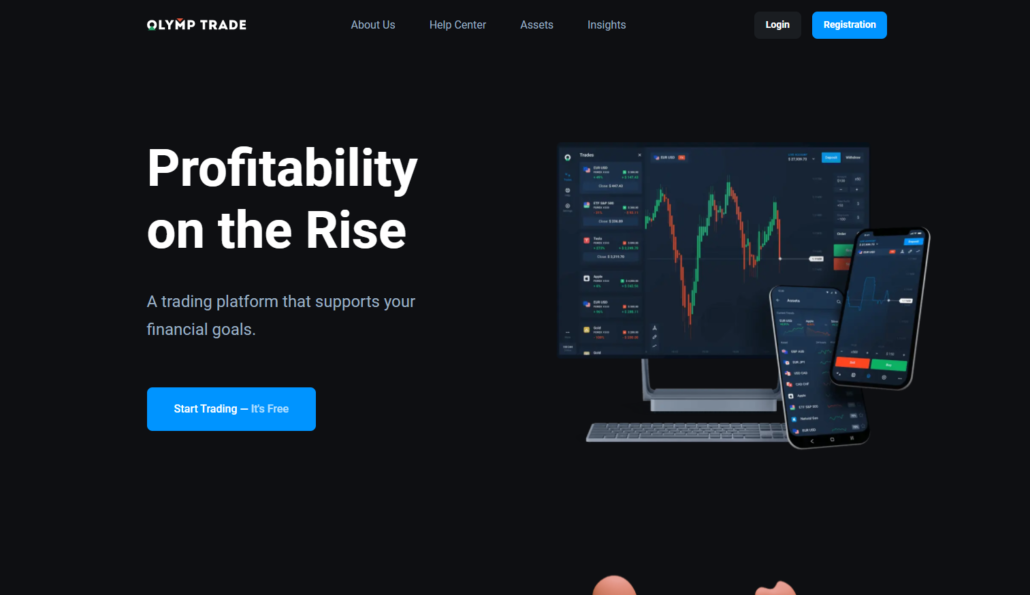A Colômbia é o país de língua espanhola em América do Sul. Como comerciante colombiano, escolher o corretor ou plataforma de Opções Binárias certo é essencial para o seu sucesso como investidor. Você quer encontrar um corretor respeitável com um sólido histórico que oferece um amigo do usuário plataforma com muitos recursos. Os cinco corretores abaixo são alguns dos melhores do setor e oferecem tudo o que você precisa para ter sucesso.

Abaixo estão os cinco melhores corretores de opções binárias que você pode escolher:
Mais de 100 mercados
- Min. depósito $10
- $10,000 demo
- Plataforma profissional
- Lucro alto até 95%
- Retiradas rápidas
- Sinais
Mais de 300 mercados
- Depósito mínimo $10
- Conta de demonstração gratuita
- Alto retorno até 100% (no caso de uma previsão correta)
- A plataforma é fácil de usar
- Suporte 24/7
Mais de 100 mercados
- Aceita clientes internacionais
- Pagamentos elevados 95%+
- Plataforma profissional
- Depósitos rápidos
- Negociação Social
- Bônus grátis
Mais de 100 mercados
- Plataforma profissional
- Conta de demonstração gratuita
- Depósito mínimo $10
- Webinars e educação
- Pagamentos altos
Mais de 100 mercados
- Min. depósito $10
- $10,000 demo
- Plataforma profissional
- Lucro alto até 95%
- Retiradas rápidas
- Sinais
a partir de $10
(Aviso de risco: negociar é arriscado)
Mais de 300 mercados
- Depósito mínimo $10
- Conta de demonstração gratuita
- Alto retorno até 100% (no caso de uma previsão correta)
- A plataforma é fácil de usar
- Suporte 24/7
a partir de $10
(Aviso de risco: seu capital pode estar em risco)
Mais de 100 mercados
- Aceita clientes internacionais
- Pagamentos elevados 95%+
- Plataforma profissional
- Depósitos rápidos
- Negociação Social
- Bônus grátis
a partir de $50
(Aviso de risco: negociar é arriscado)
Mais de 100 mercados
- Plataforma profissional
- Conta de demonstração gratuita
- Depósito mínimo $10
- Webinars e educação
- Pagamentos altos
a partir de $10
(Aviso de risco: negociar é arriscado)
O que você vai ler neste Post
Lista dos 4 melhores corretores binários da Colômbia
Geralmente, existem muitos adequados corretores de opções binárias No mundo todo. Com tantas opções, é difícil manter uma visão geral. Por isso, selecionamos os melhores para você. Então, vamos saber mais sobre o melhores corretores binários na Colômbia.
1. Quotex
Quotex é um regulamentado corretora que oferece aos seus traders uma ampla gama de ativos e opções. A Quotex está em operação desde 2014 e é propriedade da FBS Markets Inc.

A Quotex é uma corretora de opções binárias com sede nas Ilhas Marshall. Ele oferece um ampla gama de ativos, incluindo ações, commodities, índices e pares de Forex. Quotex é um dos poucos corretores que oferecem uma conta demo com não requer depósito.
Quotex é uma escolha popular entre os traders de Opções Binárias por causa de sua amigo do usuário plataforma. A plataforma está disponível em idiomas diferentes.
Recursos:
- Depósito mínimo baixo de apenas $10
- Livre Conta de demonstração Quotex com $10.000 em fundos virtuais
- O processo de retirada leva 24 horas.
- Amigo do usuário plataforma adequada para iniciantes e comerciantes experientes
- Ampla gama de ativos subjacentes, incluindo pares de moedas, ações, índices e commodities
- Spreads competitivos começam a partir de apenas um pip.
- Parâmetros de negociação personalizáveis incluindo nível de risco, tempo de expiração e valor do investimento
- 24/7 suporte Quotex via chat ao vivo, e-mail ou telefone.
(Aviso de risco: seu capital pode estar em risco)
2. Opção de QI
IQ Option é um corretor de opções binárias que oferece negociação on-line para vários ativos, incluindo ações, pares forex, commodities e criptomoedas.

A plataforma IQ Option é um plataforma proprietária que está disponível como uma plataforma baseada na Web, um aplicativo móvel e um aplicativo de desktop. A plataforma foi projetada tanto para comerciantes novatos e experientes. Isso é Simples e fácil de usar, mas oferece muitos recursos e ferramentas.
IQ Option oferece uma ampla gama de ativos para negociar, incluindo pares de moedas, ações, índices, commodities e criptomoedas.
Recursos:
- Corretor de opções binárias com um depósito mínimo de apenas $10
- conta de demonstração IQ Option com $10.000 dinheiro virtual
- Uma conta real com até 92% lucro
- 24/7 Suporte IQ Option
- Aplicativo de negociação móvel
- Mais de 500 ativos para negociar
- IQ Option fornece Webinars e tutoriais para seus comerciantes.
(Aviso de risco: seu capital pode estar em risco)
3. Opção de bolso
Pocket Option é uma corretora de opções binárias fundada em 2017. A empresa está sediada nas Ilhas Marshall e é de propriedade da Gembell Limited.

O site Pocket Option está disponível em 10 idiomas diferentes. O depósito mínimo para abrir uma conta é $50, e o tamanho mínimo de negociação é $1. Ele oferece um conta de demonstração IQ Option com dinheiro virtual.
Pocket Option oferece uma grande variedade de ativos para negociar, incluindo pares de moedas, commodities, ações e índices. A corretora também oferece vários recursos exclusivos, como o comércio social.
Recursos:
- Torneios de negociação: Todos os dias, torneios diferentes com grandes prêmios
- Bônus de depósito 50%
- Proteção de negociação 100%n
- Depósito mínimo da Pocket Option apenas $50
- Comércio mínimo de $1
- Até 96% lucro /negocie em apenas 30 segundos
- Os métodos de depósito incluem cartão de crédito, carteira eletrônica ou bitcoin
- Retirar seus lucros é rápido e fácil
- 24/7 suporte ao vivo
(Aviso de risco: seu capital pode estar em risco)
4. Olymp Trade
Olymp Trade é um corretor de opções binárias que oferece negociação online em vários ativos, incluindo moedas, ações, commodities e índices. Olymp Trade é propriedade de uma holding chamada Smartex Internacional Ltda. Olymp Trade está registrado em São Vicente e Granadinas e regulamentado por um organização internacional independente que fornece serviços de resolução de disputas para negociação de forex, CFD e opções binárias.

O site da empresa está disponível em 14 idiomas, incluindo inglês, francês, espanhol, russo e tailandês. O Olymp Trade oferece suporte ao cliente 24 horas por dia, 7 dias por semana, via live.
Recursos:
- UMA plataforma amigável que é adequado para ambos iniciantes e comerciantes experientes
- UMA ampla gama de ativos, incluindo forex, ações, commodities e criptomoedas
- Um depósito mínimo de apenas $10
- UMA conta de demonstração Olymp Trade com $10.000 em fundos virtuais
- UMA aplicativo Olymp Trade para dispositivos Android e iOS
- 24/7 suporte ao cliente
- UMA pagamento generoso de até 92% para negociações bem-sucedidas
(Aviso de risco: seu capital pode estar em risco)
Como se inscrever para um corretor de opções binárias na Colômbia
Os corretores de opções binárias oferecem uma maneira simples para os comerciantes apostarem se o o preço de um ativo vai subir ou descer ao longo de um tempo definido. Ao se inscrever em um corretor de opções binárias, você precisará fornecer alguns informação pessoal e financiar a sua conta.

Aqui estão os passos que você precisa seguir para se inscrever em um corretor de opções binárias:
1. Escolha um corretor – Existem muitas opções binárias diferentes. Faça alguma pesquisa para encontrar um que se adapte ao seu estilo de negociação e necessidades.
2. Crie a sua conta aqui – Depois de escolher um corretor, você pode criar uma conta no site do corretor.
3. Deposite fundos em sua conta, e você pode começar a negociar
(Aviso de risco: seu capital pode estar em risco)
As opções binárias são legais na Colômbia?
A negociação de opções binárias é jurídico Na colômbia. O país é membro da Fundo Monetário Internacional e a Banco Mundial, e sua economia é relativamente diversificado. Há sem restrições à negociação de câmbio, e os corretores de opções binárias podem operar livremente no país.
As opções binárias são legais na Colômbia. No entanto, existem algumas restrições sobre como eles podem ser negociados. Por exemplo, Opções Binárias não podem ser negociadas na Bolsa de Valores da Colômbia.
(Aviso de risco: seu capital pode estar em risco)
Regulação financeira na Colômbia
A regulamentação financeira na Colômbia é um pouco diferente da de outros países. O setor financeiro é supervisionado pelo Superintendência de Bancos e Seguros, que faz parte do Ministério das Finanças. A Superintendência garante que bancos e seguradoras operar com segurança e solidez, proteger os consumidores, e promover estabilidade financeira.

A Colômbia tem dois tipos principais de instituições financeiras: bancos e instituições financeiras não bancárias. Os bancos estão sujeitos a mais regulamentação do que as instituições financeiras não bancárias.
O cenário regulatório financeiro na Colômbia é em constante evolução. As mudanças mais recentes foram em resposta à pandemia global, que impactou significativamente a economia.

O governo colombiano tomou várias medidas para proteger o sistema financeiro do país das pandemias. Eles implementaram várias medidas, incluindo:
- O aumento do capital exigido para os bancos
- introduzindo um moratória no pagamento de empréstimos
- garantia de depósitos até um determinado montante
(Aviso de risco: seu capital pode estar em risco)
Como depositar fundos para negociação de opções binárias na Colômbia
Depositar fundos em sua conta de negociação de opções binárias é bastante simples. A maioria dos corretores oferecerá um variedade de métodos de depósito, Incluindo cartões de crédito, transferências bancárias, e carteiras eletrônicas como PayPal ou Skrill.

Para fazer um depósito, escolha o seu método preferido e siga as instruções no site da corretora. Uma vez que os fundos tenham sido transferidos com sucesso, você pode comece a negociar imediatamente.
(Aviso de risco: seu capital pode estar em risco)
Como retirar
O processo de retirada de fundos da sua conta de opções binárias é bastante simples. Na maioria dos casos, você deve fazer login em sua conta e solicitar uma retirada. Os fundos serão então transferidos para sua conta dentro de alguns dias.

No entanto, há algumas coisas que você deve ter em mente ao retirar fundos de sua conta de opções binárias:
- Você provavelmente será cobrado uma taxa para cada retirada que você fizer.
- Você pode ser obrigado a fornecer documentos de identificação para verificar sua identidade.
- Você deve ser limitado na quantidade de dinheiro você pode retirar da sua conta.
(Aviso de risco: seu capital pode estar em risco)
Como negociar opções binárias na Colômbia: tutorial completo
Quando se trata de negociar opções binárias, há várias coisas diferentes que você precisa levar em consideração. Isso inclui o fato de que existem vários diferentes tipos de opções binárias disponíveis, bem como o fato de existirem vários diferentes maneiras que você pode negociá-los. Neste artigo, forneceremos uma visão geral de como alterar as opções binárias, bem como algumas dicas sobre como melhorar suas chances de sucesso.

Aqui está um guia passo a passo detalhado sobre como negociar opções binárias com eficiência e obter bons retornos:
Passo #1: Estude as tendências do mercado de opções binárias
Para ser um trader de opções binárias bem-sucedido, você precisa ser capaz de ler e entender Tendências de mercado. Ao entender as tendências do mercado, você pode fazer decisões mais bem informadas sobre em qual direção o mercado provavelmente se moverá.

Há muitos métodos para estudar as tendências do mercado:
- Um método é usar linhas de tendência. As linhas de tendência são uma ferramenta que os analistas técnicos usam para identificar a direção de um mercado. Eles são criados conectando uma série de altos ou baixos em um gráfico de preços.
- Outra forma de estudar as tendências do mercado é usar indicadores técnicos. Os indicadores técnicos são cálculos matemáticos que são usados para estudar o mercado também.
(Aviso de risco: seu capital pode estar em risco)
Etapa #2: Escolha seu mercado
Quando você está negociando opções binárias, escolhendo um mercado você entende é essencial. Você terá mais sucesso se negociar em um mercado com o qual esteja familiarizado e entenda bem.

Existem muitos mercados diferentes em que você pode negociar, por isso é essencial pesquisar e encontrar um que se adapte às suas necessidades. Você deve considerar o tipo de ativos você deseja negociar, o período de tempo que você deseja negociar dentro, e as nível de risco com o qual você se sente confortável.

Etapa #3: Escolha um preço de exercício e o vencimento do contrato
Ao negociar opções binárias, a chave para o sucesso é escolher o preço de exercício e a data de vencimento corretos.
- O preço de exercício é o preço pelo qual um trader comprar ou vender o ativo subjacente. Ao escolher um preço de exercício, você deve considerar o volatilidade do ativo subjacente.
- A data de vencimento é a data em que o contrato de opção expira. O contrato expirará se não for exercido até essa data.

Passo #4: Coloque a negociação
Ao negociar opções binárias, há algumas coisas que você precisa fazer para fazer uma negociação bem-sucedida:
- Em primeiro lugar, é importante que você tenha um compreensão clara do que você está fazendo. Você só deve negociar com dinheiro que você pode perder, e você deve sempre esteja ciente dos riscos envolvidos.
- Em segundo lugar, você precisa escolher um corretor respeitável com um bom histórico. Corretores lá fora são criados iguais. Faça sua pesquisa e certifique-se de selecionar um corretor regulamentado com boa reputação.

Etapa #5: Saia da negociação ou espere até que a atividade de negociação expire
Quando você está em uma negociação de Opções Binárias, você pode sair da negociação antes que ela expire. Isso pode ser feito por vendendo o contrato de opções de volta ao corretor. Você sairá da negociação com um lucro se o preço de mercado estiver acima do preço de exercício quando você vender o contrato. Se o preço de mercado estiver abaixo do preço de exercício quando você vender o contrato, você sairá da negociação com um perda.

Se você quiser esperar até que a opção binária expire, você sairá da negociação com um lucro ou prejuízo, dependendo do preço final de mercado e do preço de exercício.
Conclusão: A negociação de opções binárias está disponível na Colômbia
Este artigo fornece uma comparação dos cinco melhores corretores de negociação de opções binárias. Ao compreender o Características e benefícios de cada plataforma, você pode escolher aquela mais adequado às suas necessidades.

Também fornecemos um guia para negociar opções binárias para que você possa comece imediatamente.
(Aviso de risco: seu capital pode estar em risco)








